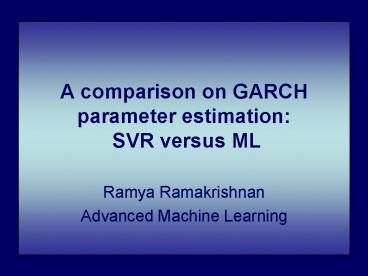A comparison on GARCH parameter estimation: SVR versus ML - PowerPoint PPT Presentation
1 / 9
Title:
A comparison on GARCH parameter estimation: SVR versus ML
Description:
A comparison on GARCH parameter estimation: SVR versus ML Ramya Ramakrishnan Advanced Machine Learning Overview GARCH is a well known method in the financial ... – PowerPoint PPT presentation
Number of Views:90
Avg rating:3.0/5.0
Title: A comparison on GARCH parameter estimation: SVR versus ML
1
A comparison on GARCH parameter estimation SVR
versus ML
- Ramya Ramakrishnan
- Advanced Machine Learning
2
Overview
- GARCH is a well known method in the financial
community for modeling and predicting the
conditional volatility of market returns - Assumes data is normally distributed and
parameter estimates are based on ML procedures - Financial data is rarely normally distributed
leptokurtic - We use Support Vector Regression (SVR) to
estimate the parameters of GARCH - SVR does not assume that there is a probability
density function over the return series and it
adjusts the parameters based on empirical risk
minimization - SVR defines an insensitivity zone that results in
its ability to deal with any pdf - Results on simulation and experimental data show
- GARCH models can be accurately estimated using
SVR - SVR estimates have higher predictive ability that
those obtained using ML methods
3
Methodology
4
Understanding GARCH(1,1)Generalized
Autoregressive Conditional Heteroskedasticity
- GARCH
- heteroskedasticity variances of the error
terms is not equal the error terms may be
expected to be larger for some points/ranges of
the data than for others - conditional heteroskedasticity
heteroskedasticity that is not random and has
autocorrelation - time varying volatility or volatility
clustering.
a process yt follows a GARCH(1,1) model if yt
µ stet st2 ? ayt-12 ßst-12 et is an
uncorrelated process with zero mean and unit
variance µ 0 without affecting model
performance Forecast yt,predict2 ?predict
(apredictßpredict)yt-1,actual2
5
Importance of GARCH in Finance
- Financial returns series often clearly exhibit
conditional heteroskedasticity (volatility
clustering) - Being able to accurately forecast volatility is
especially important in finance for risk
analysis, portfolio selection, and derivative
pricing - Goal of GARCH models is to provide a volatility
measure
6
Understanding SVRIterated Re-Weighted Least
Squares
- Problem formulation
- min Lp 0.5w2 0.5?(aiei2 ai(ei)2)
- where
- ei e yi ?(xi)w b ei e yi
?(xi)w b - ai 2ai / ei ai 2ai / ei
- Basic Procedure
- 1. Fixing ai and ai minimize Lp
- 2. Recalculate ai and ai from the solution in
step 1 - 3. Repeat until convergence
- Project Parameters
- RBF kernel exp(-xi-xj2/2s2)
- s and e terms selected by cross validation
7
Simulation Results
- Relative R-squared (R2SVR R2ML)/ R2ML
- As kurtosis increases, SVR estimates provide
better predictive results - Performance for normal distribution varies by
sample size - 1000 samples ML does marginally better
- 500 samples SVR does better than ML
10 independent trials
8
Empirical Results on SP 100 Returns
ML SVR
? 1.460 E -6 9.20 E -6
a 9.998 E -2 0.0461
ß 0.888 0.0956
Kurtosis (yt/st,predict) 5.37 5.86
LB Statistic (yt/st,predict)2 p-value 3.631 0.6028 3.661 0.599
R2 for forecast in sample out of sample 7.63 5.29 10.394 13.338
9
Conclusions
- SVR based estimates of GARCH parameters produce
more accurate predictions of financial volatility
than ML estimates - ML tries to fit the residuals to a Gaussian
distribution but if this is not the case it will
increase the error by forcing the residuals to be
Gaussian. - SVR tries to get the best fit with the data, not
relying on prior knowledge and focuses on
minimizing the prediction error with a given
machine complexity































